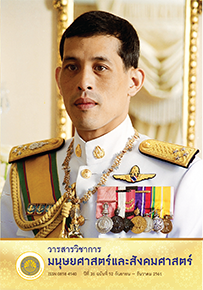Speech Rhythm of Thai Children Aged 5-7 Years
Main Article Content
Abstract
This research/study aimed to analyzed and classified the characteristics of speech rhythm among children aged 5-7 years old. Ten students from La-Or UTIS Demonstration School, five from kindergarten 3 and five from grade 1, participated in this study. The homeroom teachers selected the participants according to the following criteria: age range from 5 to 7 years old, based in Bangkok and using Standard Thai as their native language. The 30-second connected speech of each participant was recorded and each rhythmic unit duration was calculated and averaged. ANOVA was employed to compare and explain the rhythmic unit duration of each group. The results showed a significant difference between stressed and unstressed syllables. It was unclear to specify the type of speech rhythm of a child’s speech. However, it was similar to syllable-timed rhythm as the number of syllables per foot was a few. Apart from that, the emergence of stress-timed rhythm was observed in this age group.
Downloads
Article Details
บทความทุกบทความเป็นลิขสิทธิ์ของวารสารวิชาการมนุษยศาสตร์และสังคมศาสตร์ มหาวิทยาลัยบูรพาเท่านั้น
References
ผู้พูดปกติ. วิทยานิพนธ์อักษรศาสตรมหาบัณฑิต, ภาควิชาภาษาศาสตร์, คณะอักษรศาสตร์, จุฬาลงกรณ์มหาวิทยาลัย.
ญาณินท์ สวนะคุณานนท์. (2555). ค่าระยะเวลาของเสียงเรียงในภาษาเอเชียตะวันออกเฉียงใต้: นัยสำคัญต่อการจัดกลุ่มตามแนว แบบลักษณ์ภาษา. ดุษฎีนิพนธ์อักษรศาสตรดุษฎีบัณฑิต, ภาควิชาภาษาศาสตร์, คณะอักษรศาสตร์, จุฬาลงกรณ์มหาวิทยาลัย.
ธีระพันธ์ เหลืองทองคำ. (2539). จังหวะในภาษาไทย. ใน เอกสารการสอนชุดวิชาภาษาไทย 3 หน่วยที่ 1-6 (พิมพ์ครั้งที่ 7).
นนทบุรี: สาขาวิชาศึกษาศาสตร์ มหาวิทยาลัยสุโขทัยธรรมาธิราช.
ผณินทรา ธีรานนท์. (2543). หน่วยจังหวะกับการแปรของวรรณยุกต์ในคำพูดต่อเนื่องภาษาไทย. วิทยานิพนธ์อักษรศาสตรมหา
บัณฑิต, ภาควิชาภาษาศาสตร์, คณะอักษรศาสตร์, จุฬาลงกรณ์มหาวิทยาลัย.
สถาบันราชานุกูล กรมสุขภาพจิต กระทรวงสาธารณสุข. (2546). คู่มือการฝึกพูดเบี้องต้น. กรุงเทพฯ: โรงพิมพ์ชุมนุมสหกรณ์ การเกษตรแห่งประเทศไทย.
อภิญญา ห่านตระกูล และวริษา โอสถานนท์. (2558). การศึกษาเปรียบเทียบจังหวะการพูดของเด็กออทิสติกกับเด็กปกติ. วารสาร
มนุษยศาสตร์ มหาวิทยาลัยเกษตรศาสตร์, 22(1), 151-180.
Abercrombie, D. (1967). Elements of general phonetics. Chicago: Aldine.
Hoequist, C., Jr. (1983). Syllable duration in stress-, syllable- and mora-timed languages. Phonetica, 40, 203-237.
Jusczyk, P.W., Houston, D., Newsome, M., (1999). The beginning of word segmentation in English-learning infants. Cognitive psychology, 39(3-4), 159-207.
Ladefoged, P., and Johnson, K. (2011). A course in phonetics (6th ed.). Boston: Wadsworth/Cengage Learning.
Laver, J. (1994). Principles of phonetics. Cambridge: Cambridge University Press.
Luangthongkum, T. (1977). Rhythm in standard Thai. Doctoral dissertation. University of Edinburgh.
Luangthongkum, T. (1984). Rhythmic groups and stress groups in Thai. In The proceedings of the international conference on Thai studies (pp. 1-10). Bangkok: Chulalongkorn Univerisity.
Mehler, J., and Christophe, A. (1995). Maturation and learning of language in the first year of life. In M.S.Gazzaniga (Ed.), The cognitive neurosciences: a handbook for the field. (pp. 943-954). Cambridge, Mass: MIT Press.
Nazzi, T., Bertoncini, J., and Mehler, J. (1998). Language discrimination by newborns: towards an understanding of the role of rhythm. Journal of experimental psychology: human perception and performance, 24(3), 756-766.
Nazzi, T. and Ramus, F., (2003). Perception and acquisition of linguistic rhythm by infants. Speech communication, 41(1), 233-243.
Nespor, M. (1990). On the rhythm parameter in phonology. In I.M. Roca. (Ed.), Logical issues in language acquisition, (pp. 157-175). Dordrecht: Foris.
Payne, E., Post, B., Astruc, L.,Prieto, P., and Vanrell, M. (2011). Measuring child rhythm. Language and speech, 55(2), 203-229.
Savithri, S., Sreedevi, N., Kavya, V. (2009). Speech rhythm in Kannada speaking children. The proceedings of the national symposium on acoustics 2009. (pp.1-6). India: All India Institute of Speech & Hearing.
Sawanakunanon, Y. (2014). Segment timing in twelve Southeast Asian languages. Manusya. special issue 20,
124-156.


